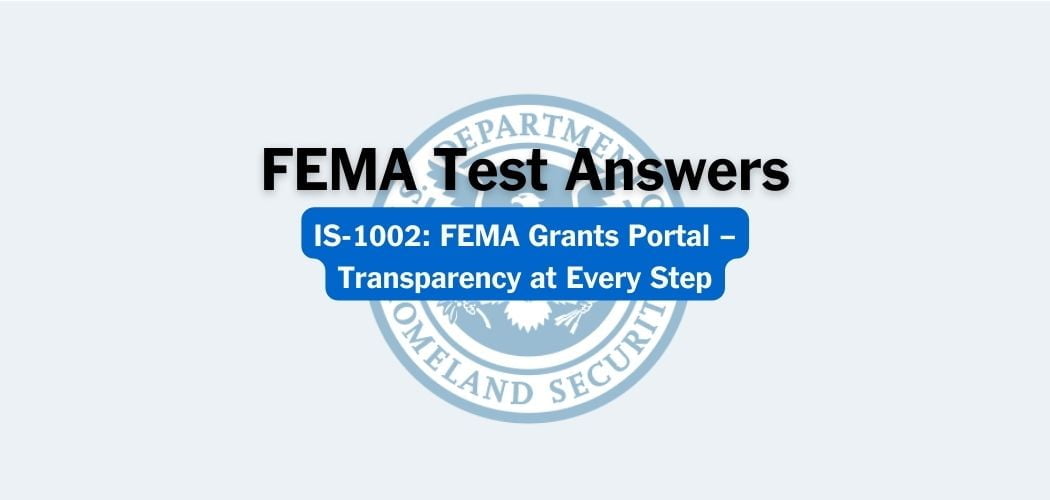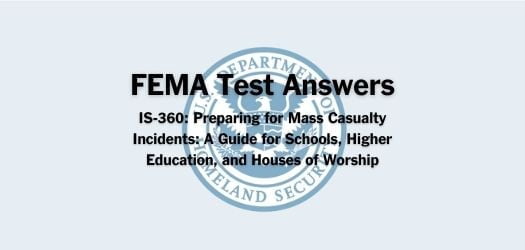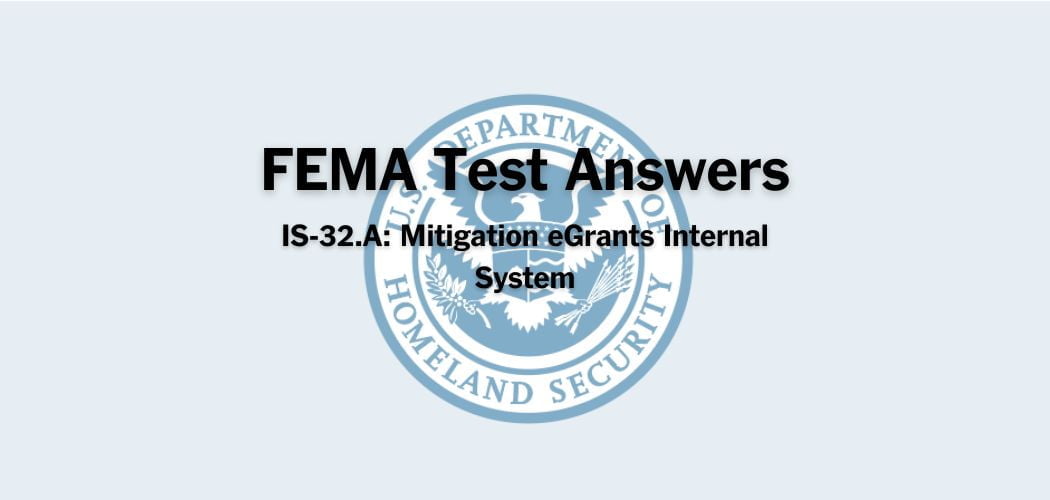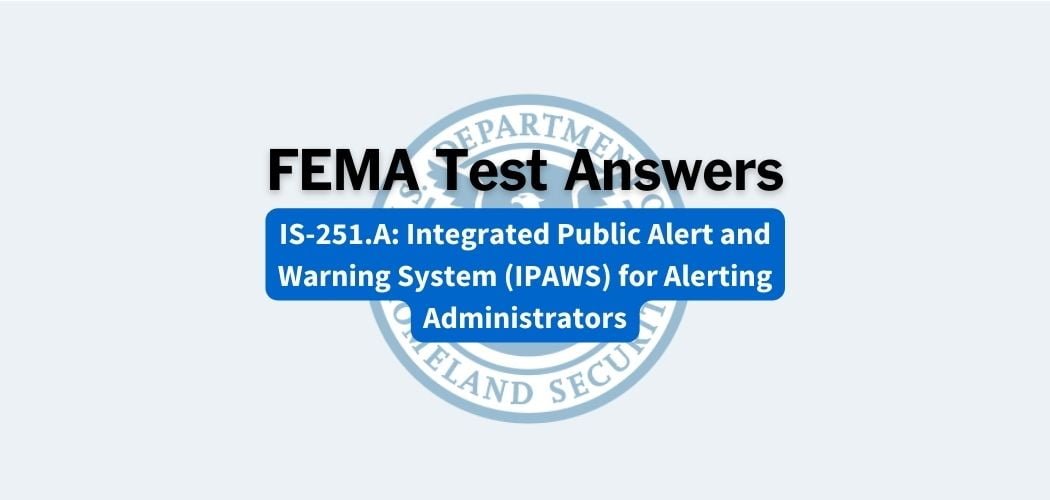Overview: The FEMA IS-1015 course was published on 2/28/2019 to provide an overview of the role of insurance in the Public Assistance process.
By the end of the IS-1015 course, State, Local, Tribal, and Territorial Applicants and Recipients will be able to understand the most common insurance considerations, compliance, and requirements as it relates to the potential impacts of Public Assistance grant funding.
FEMA IS-1015 test answers
Each time this test is loaded, you will receive a unique set of questions and answers. The test questions are scrambled to protect the integrity of the exam.
Question 1. Which of the following is the single point-of-contact assigned to each Applicant that provides assistance throughout the application process and the insurance review process?
A. FEMA Insurance Specialist
B. Program Delivery Manager✅
C. Recipient/State Insurance Specialist
D. Federal Coordinating Officer
Question 2. The _______ is designed to address high-level information for all potential Applicants.
A. Preliminary Damage Assessment
B. Applicant Briefing✅
C. Recovery Scoping Meeting
D. Recovery Transition Meeting
Question 3. Which of the following authorities applies to Major Disaster Declarations and discusses essential assistance?
A. 44 Code of Federal Regulations, 206.253
B. Stafford Act, Section 312
C. Stafford Act, Section 403✅
D. 44 Code of Federal Regulations, 206.252
Question 4. Which of the following is a formal means to manage risk through dedicated self-funding rather than through commercially available insurance?
A. Third-Party Insurance
B. Insurance Pools
C. Blanket Policy
D. Self-Insurance Plan✅
Question 5. Which of the following is a single insurance policy that provides multiple types of coverage and/or covers multiple properties?
A. Insurance Pools
B. Blanket Policy✅
C. Standard Flood Insurance Policy
D. Self-Insurance Plan
Question 6. Since insurance market conditions sometimes prevent the ability of an Applicant to reasonably obtain and maintain insurance requirements, the Robert T. Stafford Act allows the Applicant to apply for a(n):
A. Elevation Certificate
B. Claims Adjuster Certification
C. Insurance Waiver
D. Insurance Commissioner’s Certification✅
Question 7. Which page in Grants Portal provides General and Event Information and allows the Applicant to upload documents pertinent to the event as well as review the project details?
A. Event PA Requests Profile✅
B. My Projects
C. Damage Details
D. My Workflows
Question 8. All of the following are reasons that the Applicant may request that FEMA modify the insurance requirement, except:
A. The required insurance is not reasonably available
B. An alternative to the insurance requirement provides adequate protection against future loss to the property
C. The required insurance is not necessary to protect against future loss to the property
D. At the time of a previous disaster, the same property was and remains uninsured✅
Question 9. Which of the following is required documentation to support the insurance settlement review?
A. Extensions of coverage
B. Final statement of loss✅
C. Declaration pages
D. Schedule of covered locations
Question 10. For FEMA to provide Public Assistance funding for a Private Non-Profit facility in a community that does not participate in the National Flood Insurance Program, the community must agree to participate in the National Flood Insurance Program within _______ of the declaration and the Private Non-Profit must purchase the required flood insurance.
A. 1 year
B. 60 days
C. 5 months
D. 6 months✅
Question 11. The obtain and maintain requirements can be found under which tab in the expanded “Insurance Profile” bar in Grants Portal?
A. Insurance Report
B. Insurance Information✅
C. Damage Inventory
D. Insurance Summary
Question 12. Which of the following provides liability insurance coverage for all of a company’s vehicles in one policy?
A. Excess coverage policy
B. Fleet insurance policy✅
C. Auto insurance policy
D. General “All-Perils” property insurance policy
Question 13. Which of the following positions is responsible for risk management in the insurance review process by responding to requests for information from FEMA?
A. Program Delivery Manager
B. FEMA Insurance Specialist
C. Recipient/State Insurance Specialist
D. Applicant✅
Question 14. During the disaster recovery and application process, when is it important to disclose and document existing insurance coverage?
A. After the disaster recovery and application process
B. Prior to the disaster recovery and application process
C. Early in the disaster recovery and application process✅
D. Late in the disaster recovery and application process
Question 15. If the Applicant believes that its property is incorrectly identified on a Flood Insurance Rate Map, the Applicant may request a Letter of Map Amendment or Letter of Map Revision to FEMA within _______ of the disaster declaration.
A. 1 year
B. 30 days
C. 60 days✅
D. 6 months
Question 16. Which of the following is true of the FEMA requirement to obtain and maintain insurance?
A. The requirement to obtain and maintain insurance only pertains to damages from flooding
B. FEMA requires Applicants to obtain and maintain insurance for temporary facilities
C. FEMA does not apply the requirement to obtain and maintain insurance to buildings, contents, equipment, and vehicles
D. By law, Applicants must comply with the requirement to obtain and maintain insurance as a condition of FEMA assistance✅
Question 17. Which of the following is used to confirm the facility is covered under the insurance policy?
A. Proof of Loss
B. Adjuster’s estimates/reports
C. Schedule of covered locations✅
D. Declaration pages
Question 18. The requirement to purchase flood insurance is waived when eligible costs for an insurable facility:
A. do not exceed $7,000
B. exceed $5,000
C. exceed $7,000
D. do not exceed $5,000✅



